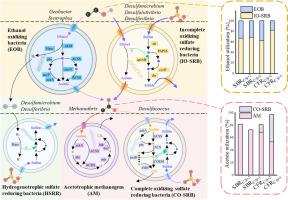富集目标硫酸盐还原菌并揭示厌氧消化生态系统中微生物相互作用的策略
IF 11.4
1区 环境科学与生态学
Q1 ENGINEERING, ENVIRONMENTAL
引用次数: 0
摘要
在处理含硫酸盐废水时,破解硫酸盐还原菌(SRB)与其他微生物之间的关系对于厌氧消化系统的稳定运行至关重要。然而,很少有研究区分厌氧消化生态系统中的不完全氧化SRB(IO-SRB)和完全氧化SRB(CO-SRB)。在两种运行模式(序批式反应器(SBR)和连续流反应器(CFR))和两种化学需氧量(COD)与硫酸盐比率(1 和 2)下运行了四个乙醇喂养生物反应器,以系统地探索富集 IO-SRB 和/或 CO-SRB 的策略及其与其他微生物的相互作用。与 SBR 相比,CFR 可提高硫酸盐去除率,并在硫酸盐和乙醇降解方面表现出更高的微生物活性。在所有反应器中,IO-SRB 都能与乙醇氧化菌竞争,当 COD/硫酸盐比从 2 降到 1 时,IO-SRB 对乙醇降解的贡献率从 62.9%-67.1% 增加到 69.0%-82.1%。此外,CO-SRB 只在 CFR 中与乙酰甲烷菌竞争,因为 CO-SRB 无法在 SBR 中有效富集。低 COD/硫酸盐比有利于脱硫球菌(CO-SRB)的富集,而 CFR 运行模式进一步加强了其富集。此外,在所有四个反应器中,富氢 SRB 的表现均优于富氢甲烷菌。总的来说,IO-SRB 和 CO-SRB 与甲烷菌之间具有不同的微生物相互作用,IO-SRB 与乙酰甲烷菌之间可能存在合成关系,而 CO-SRB 与乙酰甲烷菌之间则存在竞争关系。本文章由计算机程序翻译,如有差异,请以英文原文为准。

Strategies for enriching targeted sulfate-reducing bacteria and revealing their microbial interactions in anaerobic digestion ecosystems
Deciphering relationships between sulfate-reducing bacteria (SRB) and other microorganisms is crucial for stable operation of anaerobic digestion systems when treating sulfate-containing wastewater. However, few studies have differentiated the incomplete oxidizing SRB (IO-SRB) and complete oxidizing SRB (CO-SRB) in anaerobic digestion ecosystems. Four ethanol-fed bioreactors were operated under two operational modes (sequencing batch reactor, SBR; and continuous-flow reactor, CFR) and two chemical oxygen demand (COD) to sulfate ratios (1 and 2) to systematically explore strategies for enriching IO-SRB and/or CO-SRB and their microbial interactions with other microorganisms. Compared to SBRs, CFRs could enhance sulfate removal and demonstrated higher microbial activities in sulfate and ethanol degradation. IO-SRB competed with ethanol oxidizing bacteria in all reactors, and IO-SRB's contribution to ethanol degradation increased from 62.9%-67.1% to 69.0%-82.1% as the COD/sulfate ratio decreased from 2 to 1. Moreover, CO-SRB competed acetotrophic methanogens exclusively in CFRs, as CO-SRB could not be efficiently enriched in SBRs. Low COD/sulfate ratios facilitated the enrichment of Desulfococcus (CO-SRB), and the CFR operational mode further strengthened its enrichment. Additionally, hydrogenotrophic SRB outperformed hydrogenotrophic methanogens in all four reactors. In general, IO-SRB and CO-SRB possessed distinct microbial interactions with methanogens, with potential syntrophic relationships between IO-SRB and acetotrophic methanogens while competitive relationships between CO-SRB and acetotrophic methanogens.
求助全文
通过发布文献求助,成功后即可免费获取论文全文。
去求助
来源期刊

Water Research
环境科学-工程:环境
CiteScore
20.80
自引率
9.40%
发文量
1307
审稿时长
38 days
期刊介绍:
Water Research, along with its open access companion journal Water Research X, serves as a platform for publishing original research papers covering various aspects of the science and technology related to the anthropogenic water cycle, water quality, and its management worldwide. The audience targeted by the journal comprises biologists, chemical engineers, chemists, civil engineers, environmental engineers, limnologists, and microbiologists. The scope of the journal include:
•Treatment processes for water and wastewaters (municipal, agricultural, industrial, and on-site treatment), including resource recovery and residuals management;
•Urban hydrology including sewer systems, stormwater management, and green infrastructure;
•Drinking water treatment and distribution;
•Potable and non-potable water reuse;
•Sanitation, public health, and risk assessment;
•Anaerobic digestion, solid and hazardous waste management, including source characterization and the effects and control of leachates and gaseous emissions;
•Contaminants (chemical, microbial, anthropogenic particles such as nanoparticles or microplastics) and related water quality sensing, monitoring, fate, and assessment;
•Anthropogenic impacts on inland, tidal, coastal and urban waters, focusing on surface and ground waters, and point and non-point sources of pollution;
•Environmental restoration, linked to surface water, groundwater and groundwater remediation;
•Analysis of the interfaces between sediments and water, and between water and atmosphere, focusing specifically on anthropogenic impacts;
•Mathematical modelling, systems analysis, machine learning, and beneficial use of big data related to the anthropogenic water cycle;
•Socio-economic, policy, and regulations studies.
 求助内容:
求助内容: 应助结果提醒方式:
应助结果提醒方式:


